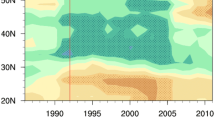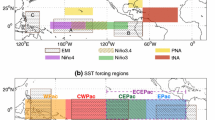Abstract
Present work compares impacts of El Niño Modoki and El Niño on anomalous climate in the Pacific rim during boreal winters of 1979–2005. El Niño Modoki (El Niño) is associated with tripole (dipole) patterns in anomalies of sea-surface temperature, precipitation, and upper-level divergent wind in the tropical Pacific, which are related to multiple “boomerangs” of ocean-atmosphere conditions in the Pacific. Zonal and meridional extents of those “boomerangs” reflect their independent influences, which are seen from lower latitudes in the west to higher latitudes in the east. In the central Pacific, more moisture is transported from the tropics to higher latitudes during El Niño Modoki owing to displacement of the wet “boomerang” arms more poleward toward east. Discontinuities at outer “boomerang” arms manifest intense interactions between tropical and subtropical/extratropical systems. The Pacific/North American pattern and related climate anomalies in North America found in earlier studies are modified in very different ways by the two phenomena. The seesaw with the dry north and the wet south in the western USA is more likely to occur during El Niño Modoki, while much of the western USA is wet during El Niño. The moisture to the southwestern USA is transported from the northward shifted ITCZ during El Niño Modoki, while it is carried by the storms traveling along the southerly shifted polar front jet during El Niño. The East Asian winter monsoon related anticyclone is over the South China Sea during El Niño Modoki as compared to its position over the Philippine Sea during El Niño, causing opposite precipitation anomalies in the southern East Asia between the two phenomena.









Similar content being viewed by others
Notes
The SACZ is not originated in the tropical Pacific but in the Amazon basin and extends toward southeastern Brazil and then protrudes into the subtropical Atlantic Ocean. Its existence certainly has interaction with both the canonical El Niño and El Niño Modoki in the eastern tropical Pacific. In this paper, we will not discuss such an interaction and its possible impacts on South America.
In the East Asian winter monsoon region, the northwest wind prevails over northern/northeastern China, Korea and Japan, while the northeast wind prevails over the southern China, the South China Sea and the western North Pacific to the south of Japan (e.g., Chan and Li 2004). We note that some studies use the term “East Asian winter monsoon region” to denote the region where northeast wind prevails (e.g., Chang et al. 2004).
References
Adler RF, Huffman GJ, Chang A, Ferraro R, Xie P, Janowiak J, Rudolf B, Schneider U, Curtis S, Bolvin D, Gruber A, Susskind J, Arkin P (2003) The version 2 global precipitation climatology project (GPCP) monthly precipitation analysis (1979-Present). J Hydrometeor 4:1147–1167
Amstrong JS (2007) Significance tests harm progress in forecasting. Int J Forecast 23:321–327. doi:10.1016/j.ijforecast.2007.03.004
Ashok K, Behera S, Rao AS, Weng HY, Yamagata T (2007) El Niño Modoki and its teleconnection. J Geophys Res 112:C11007. doi:10.1029/2006JC003798
Baines PG (2006) The zonal structure of the Hadley circulation. Adv Atmos Sci 23:869–883
Carver R (1978) The case against statistical significance testing. Harv Educ Rev 48:378–399
Cayan DR, Redmond KT, Riddle LG (1999) ENSO and hydrologic extremes in the western United States. J Clim 12:2881–2893
Chan J, Li C (2004) The East Asia winter monsoon. In: Chang CP (ed) East Asian Monsoon. World Scientific, pp 54–106
Chang CP, Harr PA, McBride J, Hsu HH (2004) Maritime continent monsoon: annual cycle and boreal winter variability. In: Chang CP (ed) East Asian Monsoon. World Scientific, pp 107–150
Cox DR (1977) The role of significance tests. Scand J Stat 4:49–70
Dettinger MD, Cayan DR, Diaz HF, Meko DM (1998) North-south precipitation patterns in western North America on interannual-to-decadal timescales. J Clim 11:3095–3111
Diaz HF, Hoerling MP, Eischeid JK (2001) ENSO variability, teleconnections and climate change. Int J Climatol 21:1845–1862
Grimm AM, Barros VR, Doyle ME (2000) Climate variability in southern South America associated with El Nino and La Niña events. J Clim 13:35–58
Harrison DE, Larkin NK (1998) Seasonal U. S. temperature and precipitation anomalies associated with El Nino: historical results and comparison with 1997–98. Geophys Res Lett 25:3959–3962
Juneng L, Tangang FT (2005) Evolution of ENSO-related rainfall anomalies in Southeast Asia region and its relationship with atmosphere-ocean variations in Indo-Pacific sector. Clim Dyn 25. doi:10.1007/s00382-005-0031-6
Kalnay E, coauthors (1996) The NCEP/NCAR 40-year reanalysis project. Bull Am Meteor Soc 77:437–471
Keables MJ (1992) Spatial variability of mid-tropospheric circulation patterns and associated surface climate in the United States during ENSO winters. Phys Geogr 13:331–348
Kerr RA (2006) Rivers in the sky are flooding the world with tropical waters. Science 313:435
Kiladis GN, Diaz HF (1989) Global climatic anomalies associated with extremes in the Southern Oscillation. J Clim 2:1069–1090
Kumar KK, Rajagopalan B, Hoerling M, Bates G, Cane M (2006) Unraveling the mystery of Indian Monsoon failure during El Niño. Science 314:115–119, doi:10.1126/science.1131152
Larkin NK, Harrison DE (2005a) On the definition of El Nino and associated seasonal average U.S. weather anomalies. Geophys Res Lett 32:L13705. doi:10.1029/2005GL022738
Larkin NK, Harrison DE (2005b) Global seasonal temperature and precipitation anomalies during El Nino autumn and winter. Geophys Res Lett 32: L16705. doi:10.1029/2005GL022860
Latif M, Kleeman R, Echert C (1997) Greenhouse warming, decadal variability, or El Niño? An attempt to understand the anomalous 1990s. J Clim 10:2221–2339
Li T, Tung YC, Hwu JW (2005) Remote and local SST forcing in shaping Asian-Australian monsoon anomalies. J Meteor Soc Jpn 83:153–167
Lindzen RS, Nigam S (1987) On the role of sea surface temperature gradients in forcing low-level winds and convergence in the tropics. J Atmos Sci 44:2418–2436
Livezey RE, Masutani M, Leetmaa A, Rui H, Ji M, Kumar A (1997) Teleconnective response of the Pacific-North American region atmosphere to large central equatorial Pacific SST anomalies. J Clim 10:1787–1820
McCabe GJ, Dettinger MD (1999) Decadal variations in the strength of ENSO teleconnections with precipitation in the western United States. Int J Climatol 19:1399–1410
McPhaden MJ (2002) El Niño and La Niña: causes and global consequences. In: MacCracken MC, Perry JS (eds) Encyclopedia of global environmental change, vol 1. Wiley, Chicester, pp 353–370
Mo KC, Higgins RW (1998) Tropical influences on California precipitation. J Clim 11:412–430
Montroy DL (1997) Linear relation of central and eastern North American precipitation to tropical Pacific sea surface temperature anomalies. J Clim 10:541–558
Newell RE, Newell NE, Zhu Y, Scott C (1992) Tropospheric rivers? A pilot study. Geophys Res Lett 19:2401–2404
Quinn WH, Burt WV (1970) Prediction of abnormally heavy precipitation over the Equatorial Pacific Dry Zone. J Appl Meteor 9:20–28
Ralph FM, Neiman PJ, Wick GA (2004) Satellite and CALJET aircraft observations of atmospheric rivers over the eastern North Pacific Ocean during the winter of 1997/98. Mon Wea Rev 132:1721–1745
Rasmusson E (1991) Observational aspects of ENSO cycle teleconnections. In: Glantz MH, Katz RW, Nichols N (eds) Teleconnections linking worldwide climate anomalies. Cambridge University Press, London, pp 309–343
Rasmusson EM, Carpenter TH (1982) Variation in tropical sea surface temperature and surface wind fields associated with the Southern Oscillation/El Niño. Mon Wea Rev 110:354–384
Rayner NA, Parker DE, Horton EB, Folland CK, Alexander LV, Rowell DP, Kent EC, Kaplan A (2003) Global analyses of SST, sea ice and night marine air temperature since the late nineteenth century. J Geophys Res 108. doi:10.1029/2002JD002670
Reyes S, Mejía-Trejo A (1991) Tropical perturbations in the eastern Pacific and the precipitation field over northwestern Mexico in relation to the ENSO phenomenon. Int J Climatol 11:515–528
Ropelewski CF, Halpert MS (1986) North American precipitation and temperature patterns associated with the El Niño/Southern Oscillation (EMSO). Mon Wea Rev 114:2352–2362
Sheppard PR, Comrie AC, Packin GD, Angersbach K, Hughes JK (2002) The climate of the US Southwest. Clim Res 21:219–238
Tomita T, Yasunari T (1996) Role of the northeast winter monsoon on the biennial oscillation of the ENSO/monsoon system. J Meteor Soc Jpn 74:399–413
Trenberth KE (1997) The definition of El Niño. Bull Am Meteorol Soc 78:2771–2777
Trenberth KE, Stepaniak DP (2001) Indices of El Nino evolution. J Clim 14:1697–1701
Trenberth KE, Shea DJ (2005) Relationships between precipitation and surface temperature. Geophys Res Lett 32:L14703. doi:10.1029/2005GL022760
Trenberth KE, Caron JM, Stepaniak DP, Worley S (2002) The evolution of ENSO and global atmospheric surface temperatures. J Geophys Res 107. doi:10.1029/2000JD000298
Van Loon H, Madden RA (1981) The southern oscillation, Part I: global associations with pressure and temperature in the northern winter. Mon Wea Rev 109:1150–1162
Wallace JM, Gutzler DS (1981) Teleconnections in the geopotential height field during the Northern Hemisphere winter. Mon Wea Rev 109:784–812
Waliser DE, Gautier C (1993) A satellite-derived climatology of the ITCZ. J Clim 6:2162–2174
Wang B, Wu R, Fu X (2000) Pacific-East Asian teleconnection: how does ENSO affect East Asian climate? J Clim 13:1517–1536
Weng HY, Ashok K, Behera S, Rao AS, Yamagata T (2007) Impacts of recent El Niño Modoki on dry/wet conditions in the Pacific rim during boreal summer. Clim Dyn 29:113–129. doi:10.1007/s00382-007-0234-0
Zhang Y, Sperber K, Boyle J (1997) Climatology and interannual variation of the East Asian winter monsoon: Results from the 1979–95 NCEP/NCAR reanalysis. Mon Wea Rev 125:2605–2619
Zhu Y, Newell RE (1994) Atmospheric rivers and bombs. Geophys Res Lett 21:1999–2002
Acknowledgments
We are thankful to Y. He for the U.S. 102-division rainfall data, to S.-W. Wang and J.-B. Huang for the 160-station rainfall data in China, and to R.-C. Zhang for the help in processing rainfall data in Japan. Our special thanks go to K. Ashok, R. Lukas, J. McCreary, M. McPhaden, G. Meyers, S. A. Rao, and Z. Yu for inspiring discussions. We appreciate the constructive comments from two anonymous reviewers.
Author information
Authors and Affiliations
Corresponding author
Rights and permissions
About this article
Cite this article
Weng, H., Behera, S.K. & Yamagata, T. Anomalous winter climate conditions in the Pacific rim during recent El Niño Modoki and El Niño events. Clim Dyn 32, 663–674 (2009). https://doi.org/10.1007/s00382-008-0394-6
Received:
Accepted:
Published:
Issue Date:
DOI: https://doi.org/10.1007/s00382-008-0394-6




